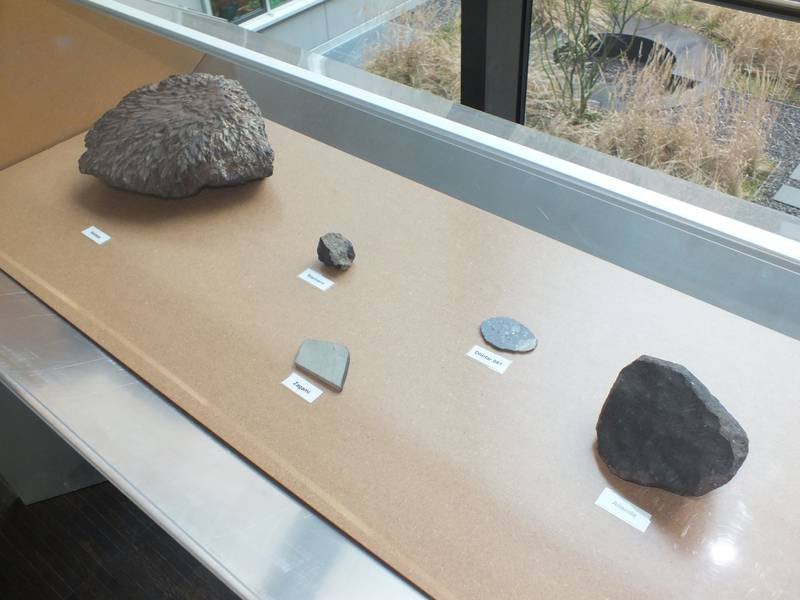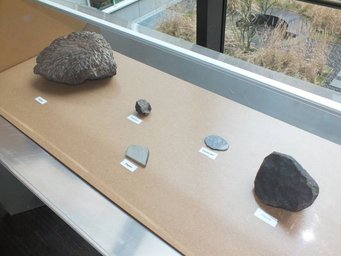Meteorites – Witnesses from Space

Station 7
Meteorites are impressive witnesses to the formation of the solar system. The name comes from a Greek work meaning ‘present in air’. However, most meteors that fall to Earth represent just a fraction of the original material. Most of it burns up on entering the Earth‘s atmosphere. Most meteorites are rocks from the roughly 4.6-billion-year-old asteroids form a belt between Mars and Jupiter. Meteorites from the younger surfaces of Mars and the moon are rarer and of especially high scientific value.
Just as mass spectrometry was the method of choice at the MPI for Chemistry for decades, meteorites were the common test object. Josef Mattauch investigated the first meteorites as early as the 1940s. Friedrich Paneth founded the Cosmochemistry Department in Mainz in 1953 with the aim of determining the age of rocks from space. With the help of mass spectrometry, it was possible to detect trace amounts of noble gases in meteorites.
One of Paneth’s students, Heinrich Wänke, took up the mantle of meteorite research in the 1960s and amassed an extensive collection. It comprises roughly 1900 meteorites from every continent on Earth. After the closure of the Cosmochemistry Department, the Institute sent its meteorite collection on long-term loan to the Senckenberg Research Institute in Frankfurt in June 2005.
Extraterrestrial Flying Objects
Exhibit 7: Six meteorites from the Senckenberg collection

For Heinrich Wänke, meteorites were important objects of study. He created a model of the formation of asteroids and the inner planets of the solar system based on chemical analyses.
Most of the meteorites shown here come from the meteorite collection of the Max Planck Institute for Chemistry, which is permanently housed in the Senckenberg Museum in Frankfurt.
The Stannern meteorite shower in the Czech Republic on May 22, 1808 is one of the most important historical meteorite showers. A total of 66 stones with a weight of about 52 kilograms were found there. All stones are covered with a remarkably shiny fusion crust. The Stannern meteorites are a basaltic rock (eucrite) and belong to the HED meteorite group, which is believed to have originated from the asteroid (4) Vesta.
On October 3, 1962, the fall of an 18 kilogram meteorite was observed near Zagami in Nigeria. Subsequent investigations showed that the meteorite crystallized from a molten rock on the surface of the planet Mars about 160 million years ago. Zagami contains black glass veins with trapped atmospheric gases similar in composition to the atmosphere of Mars. Their formation is attributed to meteorite impacts on Mars.
In the desert of the Sultanate of Oman, the 174 gram lunar meteorite Dhofar 081 was found in November 1999. The meteorite is known as "breccia" from the lunar highlands. Breccias consist of fragments of rock that have been broken up and melted by impacts on the lunar surface. Comparison with rock material brought back by the Apollo missions confirmed the lunar origin of the meteorite Dhofar 081.
On February 8, 1969, an extremely large shower of rocks with a total weight of about 2,000 kilograms fell on the town of Allende in the province of Chihuahua, Mexico. Many pieces were quickly distributed to museums and research institutes such as the Max Planck Institute for Chemistry. They served as excellent test material for newly developed methods of lunar rock analysis.
The Allende meteorite is referred to as "carbonaceous chondrite"with small melt droplets or "chondrules", and a fine-grained dark matrix. Rare bright, in part also slightly pinkish, irregularly shaped inclusions contain high concentrations of the elements calcium and aluminum. The age of these inclusions has been dated by radiometric methods to 4.56 billion years – the beginning of our solar system.
Since 1576, the iron meteorites of Campo del Cielo in Argentina have been known. These are iron meteorites with silicate rock inclusions. The site where about 1,000 fragments with a total weight of 112 tons were found is also called “Field of Heaven.”
Among the finds were several very large pieces, all individually named, including El Taco, which weighed 1998 kilograms. In 1963, El Taco was delivered to the Smithsonian Institution in Washington, D.C. Since it was not possible to disassemble the piece there, it was cut into two halves and two slices at the Max Planck Institute for Chemistry between 1965 and 1966, under the direction of Prof. Hintenberger, and this process was precisely documented.
One half was returned to Argentina, while the second half and the slices were sent to the Smithsonian Institution in Washington, D.C. The 267 kilograms of metal chips produced during the cutting remained in Mainz and were used as scientific sample material for isotope analysis and mineralogical studies.
The Horace meteorite was found in 1940 in the state of Kansas in North America. The single piece shown here weighs almost 20 kilograms and belongs to the group of the most common meteorites, known as Ordinary Chondrites. The differently shaped sides of this meteorite are interesting. On the front you can see thumbprint-like depressions which are oriented towards the center. These regmaglypts were formed during the meteorite’s passage through the Earth’s atmosphere, when the surface melted and then solidified again.
(Text by Jutta Zipfel, Senckenberg Museum, Frankfurt)

